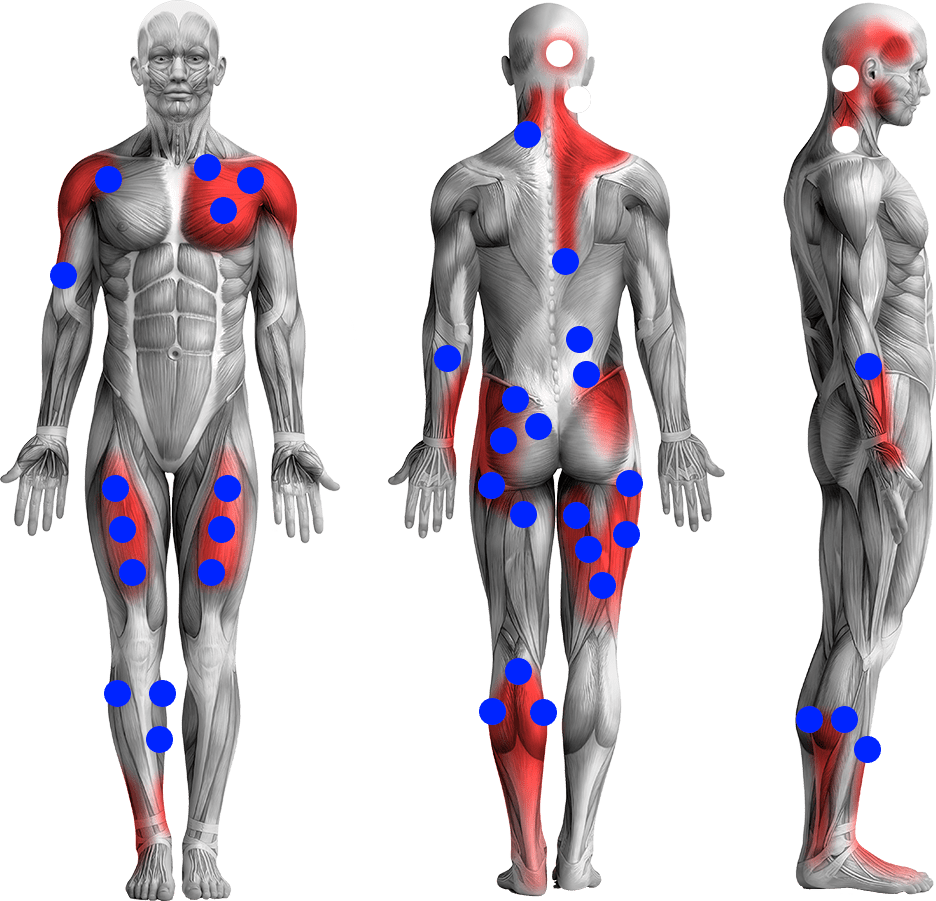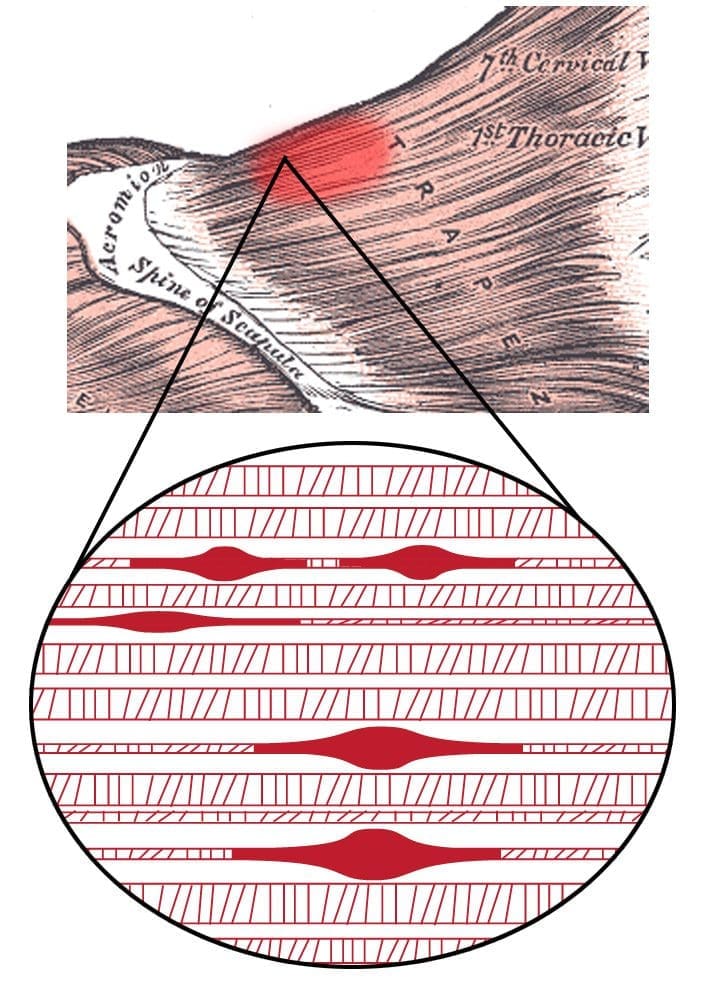Table of Contents
Introduction
The body is a complex machine with various muscles, tendons, ligaments, and vital organs that each play a specific role in maintaining functionality and stability to the host. The body allows movement and mobility from the neck down to the feet. When the body suffers from pain or has been affected by various issues that correlate with pain, two things can occur, one, where acute pain can affect the body and cause the individual to be sore for a few days or two, where the body suffers from chronic pain that leads to the development of myofascial pain syndrome that can lead to referred pain in different muscle groups and cause the body to dysfunction. Today’s article examines how to diagnose myofascial pain syndrome, how the body reacts to this condition, and how various treatments can reduce myofascial pain syndrome in the body. We refer patients to certified providers incorporating techniques and therapies for individuals dealing with myofascial pain syndrome affecting different body areas and causing functionality. By locating where the trigger points are coming from, many pain specialists utilize a treatment plan to reduce the effects that trigger points are causing on the body while coming up with a diagnosis to minimize the referred pain impacting the body. We encourage and appreciate each patient by referring them to associated medical providers based on their diagnosis when it is appropriate. We understand that education is a terrific way when asking our providers intricated questions at the patient’s request and understanding. Dr. Jimenez, D.C., only utilizes this information as an educational service. Disclaimer
How To Diagnose Myofascial Pain Syndrome
Have you been experiencing pain in different locations in your body? Do you have any areas of complaint that affect your daily lifestyle? Or do you have issues of stability and mobility when you are out and about? More often than not, approximately 25% of Americans are in some pain that can impact their lives and, if not treated right away, can cause the body to be dysfunctional. When there is constant pain in the body, it can cause overlapping risk profiles, known as myofascial pain syndrome. Myofascial pain syndrome is often defined as pain that originates along the musculoskeletal muscle groups and causes hyperirritable spots within the muscle fibers’ taut band, causing trigger points to develop. This means repetitive motions cause muscle strain and tightness along the muscle fibers when the body goes through repetitive movements daily.
When many people are dealing with myofascial pain syndrome, they would go to their primary doctor and explain that they are dealing with pain in different areas of their bodies, including their head, neck, shoulders, back, hips, etc. Afterward, their doctors conduct an examination to see where the issue is occurring. Many doctors often ask numerous questions to their patients about their daily activities before coming up with a diagnosis that myofascial pain syndrome is affecting their bodies. Studies reveal that the etiology of myofascial pain syndrome is not fully understood. Still, when the muscles, ligaments, and tissues are inflamed or undergo repetitive trauma, it can be accompanied by correlating conditions and disorders. To that point, doctors will work with their associated medical providers to develop a personalized treatment plan to diagnose and reduce myofascial pain syndrome associated with chronic conditions affecting the body.
How Does The Body React To Myofascial Pain Syndrome
Now when the body is dealing with myofascial pain syndrome, studies reveal that it can be a major health problem when it is not treated right away; it can cause the following:
- Impaired mobility
- Pain
- Muscle hypersensitivity
- Sleep issues
- Neurological issues
According to “Myofascial Pain and Dysfunction: The Trigger Point Manual,” by Dr. Janet G. Travell, M.D., the book mentioned that when myofascial pain syndrome becomes aberrant, it can lead to a disorder known as myofascial pain modulation disorder. This means that when a person is dealing with trigger points in their bodies, it can distort their referred pain patterns when being diagnosed. Active trigger points normally project pain in different body locations, known as referred pain. However, with myofascial pain modulation disorder, the pain is not localized but aberrant, which causes distortion to the central nervous system and sends pain signals to cause structural damage to the affected muscles in the body.
An Overview Of Referred Pain- Video
Have you been experiencing pain in different locations in your body? Do you have mobility issues when turning your neck or hips? Do you feel like you are losing your quality of life? If you have been dealing with pain-like problems in your body, it could be due to myofascial pain syndrome causing these issues. Myofascial pain syndrome is when the body goes through repetitive motions or trauma that causes symptoms of muscle strain and stiffness that are correlated with referred pain. The video above explains what referred pain does to the body and how it can affect the muscles and the corresponding organs. This is known as somato-visceral dysfunction, where the muscles and the related vital organs are affected, causing pain. An example would be chest pain associated with cardiovascular issues that mimic a heart attack. Various treatments can now treat myofascial pain syndrome associated with trigger points that can reduce the localized pain affecting the body.
Various Treatments To Reduce Myofascial Pain Syndrome
Several available treatments can help the body and bring back a person’s quality of life when it comes to reducing pain-like symptoms associated with myofascial pain syndrome. As stated earlier, when a person is diagnosed with myofascial pain syndrome by their primary doctors, their doctors will work with other pain specialists, like physical therapists, massage therapists, and chiropractors, that can locate where the referred pain is in the body and alleviate the symptoms. This allows the treatment plan to be personalized and catered to the individual. When myofascial pain syndrome causes the muscles to become tight and stiff due to repetitive factors, the pain specialists work with the body to restore functionality and help loosen the muscles. Not only that, but many individuals would take up meditative practices to allow their bodies to relax and reduce future trigger points from developing. This will enable them to have a clear mind and be pain-free.
Conclusion
Myofascial pain syndrome is when the body has pain-like symptoms affecting different muscle groups. It can cause numerous symptoms associated with pain that can cause mobility and dysfunction in the individual. Since the body is a complex machine that incorporates various muscles, tendons, ligaments, and vital organs to maintain functionality, myofascial pain can cause referred pain to a different location of the body and can be a major health problem. However, available treatments can reduce the pain-like symptoms caused by myofascial pain syndrome. When doctors work with associated medical providers specializing in myofascial pain syndrome, they can develop a personalized treatment plan to reduce future pain-like symptoms associated with myofascial pain syndrome from causing more issues to the body and even reduce correlating conditions that overlap that trigger myofascial pain.
References
Cao, Qi-Wang, et al. “Expert Consensus on the Diagnosis and Treatment of Myofascial Pain Syndrome.” World Journal of Clinical Cases, U.S. National Library of Medicine, 26 Mar. 2021, https://www.ncbi.nlm.nih.gov/pmc/articles/PMC8017503/.
Desai, Mehul J, et al. “Myofascial Pain Syndrome: A Treatment Review.” Pain and Therapy, U.S. National Library of Medicine, June 2013, https://www.ncbi.nlm.nih.gov/pmc/articles/PMC4107879/.
Jafri, M Saleet. “Mechanisms of Myofascial Pain.” International Scholarly Research Notices, U.S. National Library of Medicine, 2014, https://www.ncbi.nlm.nih.gov/pmc/articles/PMC4285362/.
Niddam, D M, et al. “Brain Structural Changes in Patients with Chronic Myofascial Pain.” European Journal of Pain (London, England), U.S. National Library of Medicine, Jan. 2017, https://pubmed.ncbi.nlm.nih.gov/27352085/.
Travell, J. G., et al. Myofascial Pain and Dysfunction: The Trigger Point Manual: Vol. 2:the Lower Extremities. Williams & Wilkins, 1999.
Disclaimer
Post Disclaimer
Professional Scope of Practice *
The information on this blog site is not intended to replace a one-on-one relationship with a qualified healthcare professional or licensed physician and is not medical advice. We encourage you to make healthcare decisions based on your research and partnership with a qualified healthcare professional.
Blog Information & Scope Discussions
Welcome to El Paso's Premier Wellness and Injury Care Clinic & Wellness Blog, where Dr. Alex Jimenez, DC, FNP-C, a board-certified Family Practice Nurse Practitioner (FNP-BC) and Chiropractor (DC), presents insights on how our team is dedicated to holistic healing and personalized care. Our practice aligns with evidence-based treatment protocols inspired by integrative medicine principles, similar to those found on this site and our family practice-based chiromed.com site, focusing on restoring health naturally for patients of all ages.
Our areas of chiropractic practice include Wellness & Nutrition, Chronic Pain, Personal Injury, Auto Accident Care, Work Injuries, Back Injury, Low Back Pain, Neck Pain, Migraine Headaches, Sports Injuries, Severe Sciatica, Scoliosis, Complex Herniated Discs, Fibromyalgia, Chronic Pain, Complex Injuries, Stress Management, Functional Medicine Treatments, and in-scope care protocols.
Our information scope is limited to chiropractic, musculoskeletal, physical medicine, wellness, contributing etiological viscerosomatic disturbances within clinical presentations, associated somato-visceral reflex clinical dynamics, subluxation complexes, sensitive health issues, and functional medicine articles, topics, and discussions.
We provide and present clinical collaboration with specialists from various disciplines. Each specialist is governed by their professional scope of practice and their jurisdiction of licensure. We use functional health & wellness protocols to treat and support care for the injuries or disorders of the musculoskeletal system.
Our videos, posts, topics, subjects, and insights cover clinical matters and issues that relate to and directly or indirectly support our clinical scope of practice.*
Our office has made a reasonable effort to provide supportive citations and has identified relevant research studies that support our posts. We provide copies of supporting research studies available to regulatory boards and the public upon request.
We understand that we cover matters that require an additional explanation of how they may assist in a particular care plan or treatment protocol; therefore, to discuss the subject matter above further, please feel free to ask Dr. Alex Jimenez, DC, APRN, FNP-BC, or contact us at 915-850-0900.
We are here to help you and your family.
Blessings
Dr. Alex Jimenez DC, MSACP, APRN, FNP-BC*, CCST, IFMCP, CFMP, ATN
email: coach@elpasofunctionalmedicine.com
Licensed as a Doctor of Chiropractic (DC) in Texas & New Mexico*
Texas DC License # TX5807
New Mexico DC License # NM-DC2182
Licensed as a Registered Nurse (RN*) in Texas & Multistate
Texas RN License # 1191402
ANCC FNP-BC: Board Certified Nurse Practitioner*
Compact Status: Multi-State License: Authorized to Practice in 40 States*
Graduate with Honors: ICHS: MSN-FNP (Family Nurse Practitioner Program)
Degree Granted. Master's in Family Practice MSN Diploma (Cum Laude)
Dr. Alex Jimenez, DC, APRN, FNP-BC*, CFMP, IFMCP, ATN, CCST
My Digital Business Card





